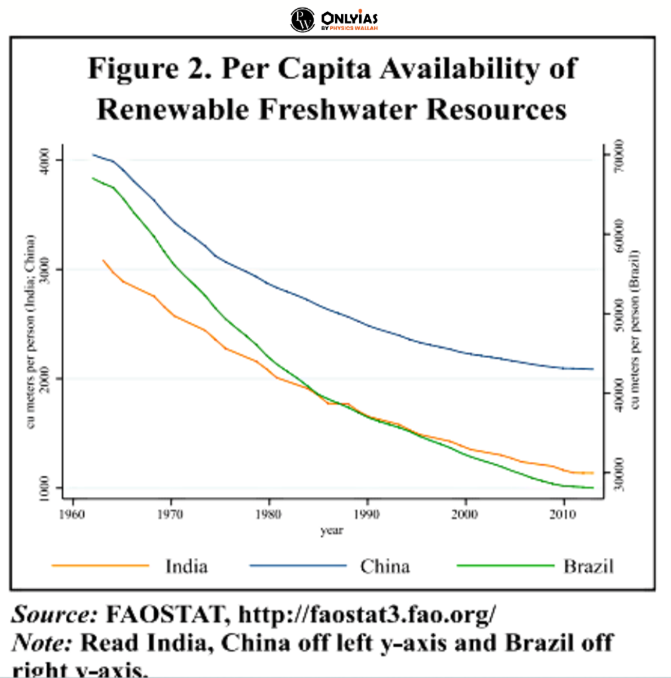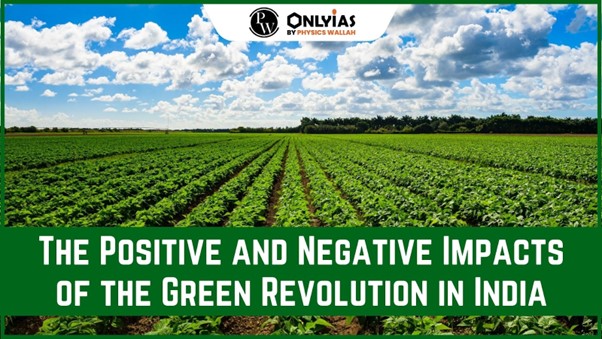Context:
| Relevancy for Prelims: Green Revolution in India, MS Swaminathan, International Rice Research Institute (IRRI), National Commission on Farmers (NCF), and Minimum Support Price.
Relevancy for Mains: Green Revolution in India, High-yielding varieties of crops, Achievements of the Green Revolution, positive and negative Impacts of the Green Revolution, and Social challenges related to the Green Revolution. |
Enroll now for UPSC Online Course
What is the Green Revolution?
- The term ‘Green Revolution’ refers to the new agricultural technology developed during the 1950s and 1960s by a team of agricultural experts at the International Centre for Maize and Wheat Improvement in Mexico and at the International Rice Research Institute (IRRI) in the Philippines.
The main focus areas of the Green Revolution in India were:
- Farm Mechanization by substituting the use of cattle with modern tractors and other machinery.
- the use of hybrid varieties of seeds for better yield, and
- Irrigation using the new dams constructed post-independence for better irrigation.
|
An Introduction to the Green Revolution in India:
During the 1960s, when the country was on the brink of a mass famine and faced severe food shortages, Swaminathan collaborated with fellow scientist Norman Borlaug and others to develop high-yielding varieties of wheat and rice.
- His efforts helped the country to double the total crop yield of wheat from 12 million tons to 23 million tons in four crop seasons and ended our dependence on grain imports.
Enroll now for UPSC Online Classes
What are the achievements of the Green Revolution in India?
- India has achieved self-reliance in the production of food grains in the last several decades and is inching towards self-reliance in pulse production.
- Today, India is the world’s largest sugar-producing country and holds the second position in rice production only after China. India is also the second largest producer of wheat with a share of around 14.14 percent of the world’s total production in 2020.
- As per the 4th Advance Estimates, the production of food grains in the country is estimated at 315.72 million tonnes which is higher by 4.98 million tonnes than the production of food grains during 2020-21.
- Though the green revolution in India helped the country move out of a ship-to-mouth situation, since the mid-1980s, its second-generation environmental impact and the intensive farming it promoted started showing its impact.
What are the positive Impacts of the Green Revolution in India?
- Increase in production and productivity of food grains (Refer Image): Increased cereal production due to:
- Increase in net area under cultivation
- Growing two or more crops in a year on the same piece of land
- Use of HYV seeds
- Increase in farmer’s income:
- Since farmers and agricultural labour comprise a sizeable proportion of the rural population, a rise in their income is due to agricultural development.
- The per capita income of Punjab stands at Rs.1,73,873 in 2022-23 (Advance Estimates) which is higher than Rs. 1,70,620 at National level.
- Rural Expansion of demand for farm inputs, repairs & maintenance of farm tools and machines, transportation and marketing services, agro-processing, etc.
- Reduction in poverty: Due to increased income for farmers and agricultural labor.
- Bullock capitalism: Emergence of a new class of wealthy farmers and their subsequent impact on economic and agricultural policy evident post-Green Revolution especially Green Revolution belt.
Enroll now for UPSC Online Coaching
What are the Negative Impacts Of the Green Revolution in India?
- Environmental challenges:
- Decline in Soil fertility: Due to the overuse of chemical fertilizers and pesticides, making it less fertile and more susceptible to erosion. For example there had been a decline of 16 percent in the production of wheat and 17 percent in per acre wheat with increasing use of chemical fertilizers in Punjab.
- Depletion of groundwater resources: It led to a significant increase in water consumption for irrigation, which has depleted groundwater resources in many areas. Punjab has 76% groundwater blocks which are overexploited, Rajasthan has 72% and Haryana has 61%. (Ground Water Resources Assessment for 2022).
- Biodiversity and ecosystem: The Green Revolution’s focus on a few high-yielding varieties of crops (Especially Monocroping of wheat and rice) has reduced biodiversity and made agricultural ecosystems more vulnerable to pests and diseases.
- Economy challenges of Green Revolution in India:
- Debt trap: The high cost of inputs such as seeds, fertilizers, and pesticides has led many farmers to fall into debt. According to the 2019 National Sample Survey, more than 50% of India’s farmers are debt-ridden and often seek alternatives outside of agriculture, or tragically, end their own lives.
- High production costs: The Green Revolution in India has made agriculture more capital-intensive, increasing the production costs for farmers.
- Regional disparities: The benefits of the Green Revolution have been unevenly distributed, with some regions benefiting more than others ( benefits concentrated in Punjab, Haryana and Western UP regions).
- Big farmers: Small and marginal farmers have been disproportionately affected by the Green Revolution, as they have not been able to compete with large farmers who have access to more resources.
- Social challenges of Green Revolution in India
- Health: The overuse of chemical fertilizers and pesticides has led to health problems for farmers and consumers. For example, exposure to pesticides has been linked to cancer and other diseases. For example: The Malwa region in Punjab is known as the Cancer Belt with 14,682 of the 33,318 deaths.
- Farmers’ suicide: The debt burden and other challenges faced by farmers have led to a high rate of suicide in many areas. A written reply in Parliament revealed that a total of 1,056 farmers committed suicide over the past five years (2017-21) in Punjab.
- Drug abuse in Punjab: The Green Revolution in India led to a problem of drug abuse in Punjab, as many farmers turned to drugs to cope with the stress and challenges of modern agriculture.
Enroll now for UPSC Online Course
| National Commission on Farmers (NCF) chaired by Swaminathan.
One of NCF’s key recommendations was to have minimum support prices (MSP) for farmers based on the cost of production plus 50 percent return. |
Post challenges of Green Revolution in India: Shrinking Land holdings: At present, the per capita available land is only about 0.10 hectares. This is much below the world average of about 4.50 hectares. Over 75% of the landholding are less than one hectare.

- Water Scarcity: It shows that India has much lower levels of water per capita than Brazil, one of the world’s leading agricultural countries. India uses a little over 90 percent of water resources for cultivation.
- Minimum Support Price (MSP): MSP aims to provide guaranteed remunerative prices to farm produce. Against this background, farmers have been demanding a ‘legal status’ to the MSP.
- A survey by the government showed that less than 6%, or over nine crore agricultural households, are the direct beneficiaries. Further, only 19% of farmer families sold paddy under MSP, whereas only 9.7% of wheat farmers benefited from MSP.
- Climate Change: Agriculture in India is highly vulnerable to climate change and variability and the frequency of climatic extremes has increased in recent years resulting in increased risks to agricultural production and food security.
- In the absence of the adoption of adaptation measures, rainfed rice yields in India are projected to reduce by 20% in 2050 and 47% in 2080 scenarios while irrigated rice yields are projected to reduce by 3.5% in 2050 and 5% in 2080 scenarios.
ALSO READ: POVERTY AND DEVELOPMENT ISSUES
Enroll now for UPSC Online Classes
Way Forward
- Need for Evergreen Revolution in India: According to most estimates, farming is no longer remunerative and over 40 percent of farmers would like to quit if they have an option. The evergreen revolution is based on an appropriate blend of different approaches to sustainable agriculture such as organic farming, green agriculture, eco-agriculture and agriculture based on effective micro-organisms.
- Green Revolution in India 2.0: We need to improve productivity in dry-farming areas, which can grow pulses, oilseeds and other high-value crops that require less water, but many of which we continue to import.
- Natural Farming: Agroecological practices like Natural Farming are a cost-effective and ecologically compatible alternative that can help achieve the Sustainable Development Goals. They can reduce input costs, improve income and financial stability, alleviate poverty, promote gender equality, and ensure sustainable production and consumption patterns.
- Cooperative Farming: It was, therefore, necessary to make cost-effective usage of new technology on small and marginal-size holdings through some institution-building measures like the formation of group farming.
- Green Revolution to Gene Revolution: GM seeds are considered to be more productive, more pest-resistant and more suitable to all categories of farms and all the agricultural regions.
- However, the adoption of gene technology in Indian agriculture is subject to debate and discussion, as its positive and negative effects on plants, animals and human lives have not yet been fully examined.
Enroll now for UPSC Online Classes
Conclusion
Green Revolution in India, spearheaded by visionaries like MS Swaminathan, brought about unprecedented increases in agricultural productivity and self-sufficiency, its legacy reveals a nuanced tapestry of successes and challenges. However, the green revolution technology, in spite of its severe criticism on the issues related to equity, ecology and environment, thus made a remarkable contribution in transforming the Indian economy from its notorious ship-to-mouth food-deficit status to that of not only a food-self-sufficient country but even a food-surplus country.
![]() 29 Sep 2023
29 Sep 2023

